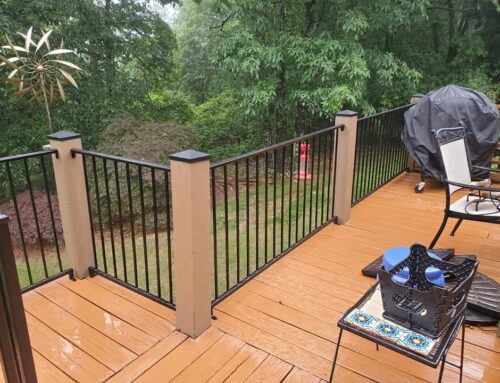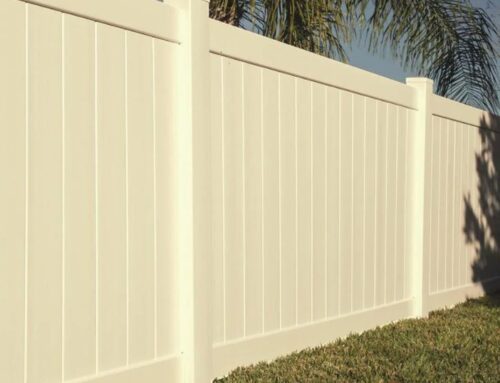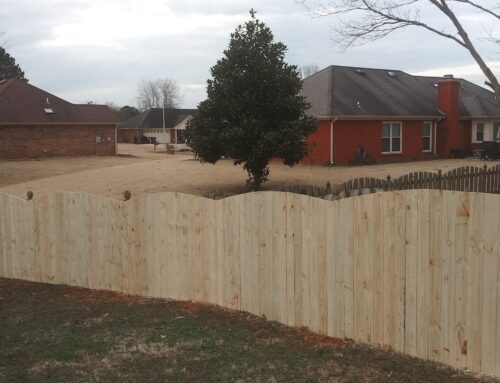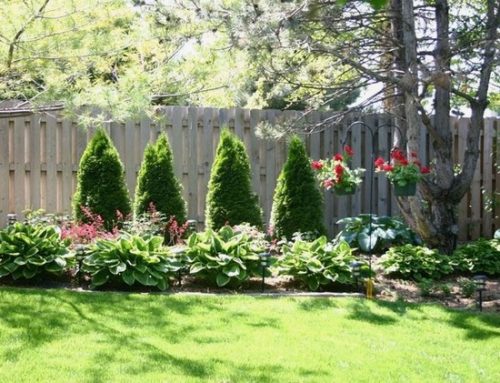Fence Around Tree on Property Line – What to Do
Dealing with a fence around a tree on the property line creates challenges for homeowners. Trees add beauty but complicate fence planning. Your fence project needs careful thought about tree growth, root systems, and legal boundaries.
Most neighborhoods have specific rules about shared trees and property lines. Talk with neighbors before starting any fence work. Consider flexible materials that bend around trunks or leave strategic gaps for growing trees.
Proper spacing protects both your fence investment and the tree’s health. Professional installers can suggest innovative solutions like curved sections or removable panels. Remember that trees continue growing for decades after your fence goes up.
What to Do When Building a Fence Around a Tree on the Property Line
Trees and fences on property lines can create tricky situations for homeowners. Here are some practical solutions.
Practical Solutions for Fencing Around Trees
| Solution | Best For | Key Advantage | Cost & Complexity | Potential Drawback |
|---|---|---|---|---|
| Create a Path Around | Valuable, large, established trees. | Preserves tree health completely; adds unique character. | Higher Cost (Custom curving); Moderate Complexity. | Requires neighbor discussion; costs more than straight runs. |
| Leave a Strategic Gap | Established trees that won’t grow much larger. | Allows natural trunk growth without touching the fence. | Low Cost (Simple gap); Low Complexity. | May allow small animals to pass through; slight loss of privacy. |
| Trim Back Branches | Trees with branches interfering with the fence line. | Prevents damage to fence materials from overhang. | Moderate Cost ($200-$500 for professional); Low Complexity. | Requires checking local shared-tree regulations; needs regular maintenance. |
| Consider Moving the Tree | Small, young trees with sentimental value. | Permanently fixes the location problem. | High Cost (Professional movers); High Complexity. | Riskier for established trees; requires a year of extra post-move care. |
| Build Between Existing Trees | Multiple trees line the property boundary. | Creates a natural, aesthetically pleasing, living boundary. | Moderate Cost (Custom-measured panels); Moderate Complexity. | Requires precise measuring and custom-cut fence sections. |
Create a Path Around
Going around might be your best option when your fence meets a tree on your property line. You can curve your fence to bypass the tree completely. This approach keeps both your fence and the tree intact. Your fence will look unique and natural in your yard. Many homeowners find this adds character to their landscape.
The curved design creates an interesting visual element while solving a practical problem. Talk with your neighbor before making this choice. They might have concerns or ideas about how the fence should look from their side. A curved fence section costs more than straight runs but saves the tree and avoids future conflicts.
Leave a Strategic Gap
Sometimes, the smartest move is to leave space between your fence and the tree. A small gap allows the tree trunk to grow naturally without pushing against your fence. The gap should be wide enough for future growth but narrow enough to maintain privacy.
You can fill this space with decorative elements like potted plants or garden stones. Some homeowners install unique panels that can be removed for maintenance. This solution works well for established trees that won’t grow much larger. Remember that gaps might allow small animals to pass through, whether good or bad, depending on your preferences.
Trim Back Branches
Pruning tree branches that interfere with your fence line solves many problems. Careful trimming keeps branches from hanging over and damaging fence materials. You’ll need to hire a professional for larger trees to avoid harm to the tree or your property.
Regular trimming every few years keeps everything in check. Check local regulations before cutting any tree on a property line. Many places have specific rules about shared trees. Depending on tree size, professional trimming ranges from $200-$500. Proper pruning helps trees stay healthy while protecting your fence investment.
Consider Moving the Tree
For smaller or younger trees, relocation might make the most sense. Moving a tree away from the property line fixes the problem permanently. Small trees are transplanted more successfully than older, established ones.
The best time for moving trees is during their dormant season. You must first prepare the new location with proper soil and drainage. Professional tree movers charge based on tree size and distance. This option works best when trees hold sentimental value but stand in problematic spots. Your relocated tree needs extra water and care for at least a year after moving.
Build Between Existing Trees
When multiple trees line your property, building fence sections creates a natural-looking boundary. This method turns trees into living fence posts that add beauty to your border. The fence flows with the landscape rather than fighting against it.
You’ll need custom-measured panels to fit between trees precisely. Wood fences work best for this approach since they can be cut to exact sizes. Metal fence sections can also be custom-ordered. This solution preserves all trees while still creating privacy. Your property line becomes a blend of natural and man-made elements that most neighbors find agreeable.
Ready to transform your Huntsville property? Contact our residential fencing experts today for a free consultation and custom design quote!
Mistakes to Avoid when Building a Fence Around Trees
Building a fence near trees requires careful planning to protect your fence and the trees on your property.
Mistakes to Avoid (Fence/Tree Checklist)
| Mistake to Avoid | The Risk | Actionable Solution | Key Measurement/Rule |
|---|---|---|---|
| Forgetting Future Growth | Expanding trunks damage and push against the fence. | Plan for future tree size when placing the fence. | Plan for at least 2-3 feet of space from the trunk. |
| Missing Legal Requirements | Costly fence removal; neighborhood disputes. | Check local codes, HOA rules, and talk with neighbors. | Get a Property Survey to mark exact boundaries. |
| Harming Tree Roots | Weakens or kills the tree slowly over time. | Avoid digging within the Drip Line (area under the branches). | Consider surface-mounted posts or hand-digging near valuable trees. |
| Skipping Tree Care Access | Trees become neglected, diseased, or damaged post-installation. | Integrate gates/access points into the fence design. | Watch for signs of stress (yellow leaves) after construction. |
| Wrong Post Placement | Roots wrap around posts; post damages tree bark; invites disease. | Use fewer posts near valuable trees. | Avoid placing metal posts directly against or extremely close to the trunk. |
Forgetting Future Tree Growth
Trees keep getting more expensive every year. Your young oak might seem small now, but it could double in size over time. Fences built too close become damaged as trunks expand and push against them.
Plan for at least 2-3 feet of space between your fence and any tree. Young trees need even more room since they’ll grow faster in their early years. Remember that branches spread outward, too, not just the trunk.
Missing Legal Requirements
Have you checked local rules about fences and trees? Many towns have strict codes about fence height, distance from property lines, and protected tree species. Your homeowner’s association might have extra rules, too.
A quick chat with neighbors prevents arguments later. Getting proper permits saves you from costly fence removal if you break regulations. Property surveys mark exact boundaries and prevent accidental building on someone else’s land.
Harming Tree Roots During Construction
Digging fence post holes can cut through important tree roots. Damaged roots weaken trees and might kill them slowly over the years. Avoid digging within the drip line (area under the branches) whenever possible.
Consider surface-mounted fence posts near valuable trees. Hand-digging causes less damage than power augers when installing posts near trees. Tree roots spread much wider than most people realize – often three times the branch spread.
Skipping Tree Care
Fences can block sunlight, change water flow, and limit access for tree maintenance. Trees need regular checks for disease and damage. Consider how you’ll reach trees for pruning after the fence goes up.
Leave access points in your fence design for tree care equipment. Watch for signs of tree stress after installing your fence – like yellow leaves or dead branches. Mulching around trees helps them stay healthy despite nearby fence construction.
Wrong Post Placement
Fence posts placed too near trees create problems for both. Roots wrap around posts over time, making removal nearly impossible. Posts pushing against trunks damage the tree bark and invite disease. Metal posts conduct heat and cold that can harm nearby trees.
Consider using fewer posts near valuable trees. Flexible fence sections allow movement as trees and ground shift over seasons. Corner posts need special attention since they bear more pressure.
Sum Up
Building a fence around a tree on the property line requires a balance between practicality and preservation. Your decisions today affect both properties for years to come. Good neighbors discuss options and find solutions that protect trees while providing privacy.
With careful planning, your fence can coexist with nature’s boundaries. The extra effort creates harmony between your landscaping needs and the living landmarks you share.
FAQ
How does improper fence placement affect tree health?
Fences too close to trees block sunlight, restrict trunk growth, damage bark, and limit water access. Root systems get crushed during installation, while soil compaction reduces oxygen flow to roots.
What are common errors in selecting materials for a fence around trees?
Choosing materials that trap moisture against the bark causes rot. Metal fences conduct extreme temperatures, which are harmful to trees. Non-flexible materials crack as trees grow, while chemically treated woods leach toxins into the soil.





